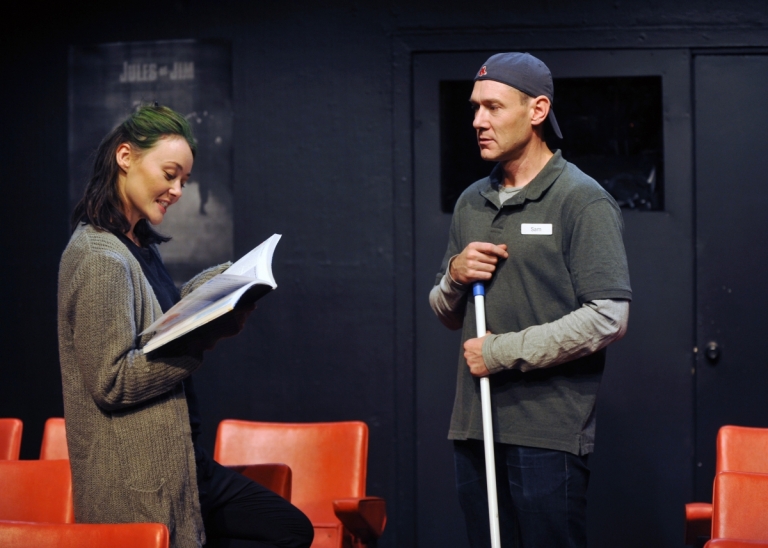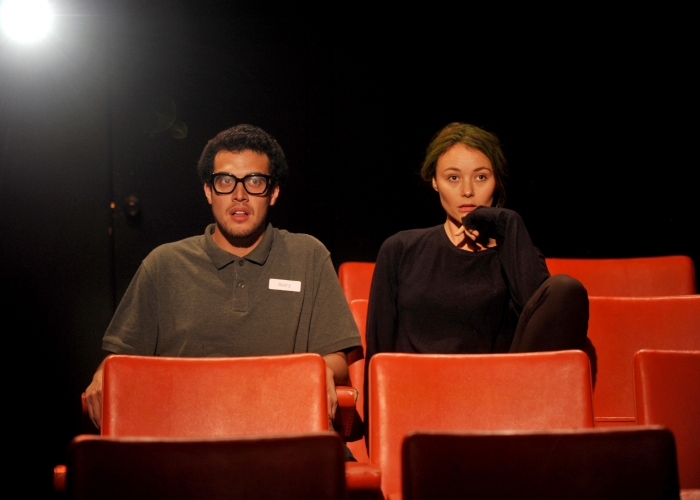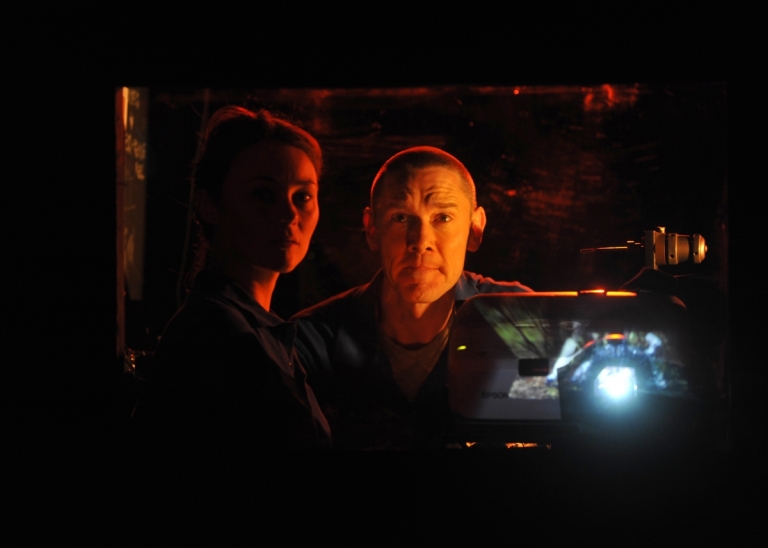Queensland Theatre and Red Stitch Actors’ production of The Flick takes a simple trio of seemingly mismatched people working in a small cinema and uses discussion of film, lifestyle choices and work ethics to open up a dialogue about a variety of issues surrounding young people’s identities 21st century society.
With its insightful characters and captivating plot, Annie Baker’s script is loaded with potential; however, the production’s direction choices deliver a mixed result. The work follows three very different cinema employees, Sam (Ben Prendergast), Avery (Kevin Hofbauer), and Rose (Ngaire Dawn Faire). While new employee Avery considers film to be a goldmine of memories and passions in life, Sam and Rose see it simply as a job that provides money for dinner and rent. The text takes its time to establish the characters individually and realistically develop their relationships with one another. The actors’ comfortable performances help to keep this slow build natural and believable; however, the drag in pace throughout the plot’s progression keeps audiences waiting for a spark of energy or major form of tension that isn’t effectively present for the first third of the production.

From Avery’s glasses and awkward demeanor to Rose’s blue hair streaks and pajama-like attire, the characters are instantly set up as stereotypes. These choices appropriately mirror a pivotal discussion when the characters discuss their personal struggles with their identities, however, the representation beyond these stereotypes is limited, resulting in a wasted opportunity for a rejection of the stereotypes. As the characters get to know one another it is evident that Sam is seen as a middle aged failure, Rose the off-the-rails “edgy” woman, and Avery the passionate yet uncomfortable privileged young man. Sam and Avery are given moments to demonstrate a depth beyond these assumptions. However, Rose’s depth and overall purpose as a character within the work seems to be reduced to little more than a supporting character who’s primary purpose is to enhance her scene partner’s development. She is only given fleeting moments to explore her true identity when prodded by her male scene partners to do so. Even in these moments, Rose’s insights into her own identity aren’t delved into enough for audiences to make a meaningful connection with her, so the attention returns to the male characters for the majority of the piece. With such a focused establishment of character and a labored progression of conflict between the three coworkers, it’s a shame that the three characters are saddled with their limiting stereotypes from start to finish.

Despite the stereotypes and fractured relationships, the actors manage to portray their flawed, misunderstood and problematic characters with grace and honesty. Hofbauer’s portrayal of Avery was the most earnest and charismatic, with a vulnerability and control throughout his lengthy monologues and a confident lead of the work’s deeper discussions and reflections between cast members. Prendergast held the most captivating and measured demonstration of his character’s hidden qualities, giving Sam a strength and hope that ensured the audience remember his presence even when absent from the stage. Finally, Fair strived to bring both an intimidating supremacy to Rose’s influence over her male counterparts and a potency during the sporadic moments of limited insight into who the character thinks she is.
Unfortunately, while the script is loaded with promise in terms of its character dynamics and discussion of film digitalization, it brushes over some of its more political elements such as racism, workplace oppression, disability prejudice, and the stigma surrounding mental health and female sexuality. The short-lived moments encapsulating these elements are the highlights of the work. The remainder of the piece is a considerably light hearted, and at times rather dry discussion of film, compatibility and identity.

Director Nadia Tass brings humility and a realistic approach to the entire production and its unassuming story. While the gradual and subtle plot progression is acceptable in script form, the piece lacked a punchy pace throughout. While having the actors literally sweep up popcorn makes logical sense for ushers cleaning a movie theatre, the choice to have the actors constantly sweeping the stage throughout the entire production caused multiple problems. The realistic cleaning often times masked, if not overshadowed, the actors’ performances and caused a constant need to reset the stage for each scene. If the sweeping up and scattering of popcorn wasn’t distracting enough for audiences to sit through, the 20 second blackouts for scene transitions in order to collect and scatter movie cinema confectionary left gaping holes where audience members disengaged. These problematic scene change choices could have been excused if the action were loaded with punch. However, the pauses between lines and dragging banter let the otherwise promising production down.
Overall Queensland Theatre’s production of The Flick was honest, believable and well contained. However, without a strong pace to drive each scene or a creative or powerful direction presence overall the work rose and fell inconsistently leaving a mixed result.
– Written by Rhumer Diball February 15th 2017
THE FLICK PRESENTED BY QUEENSLAND THEATRE AND QPAC.
10th Feb – 5th Mar
